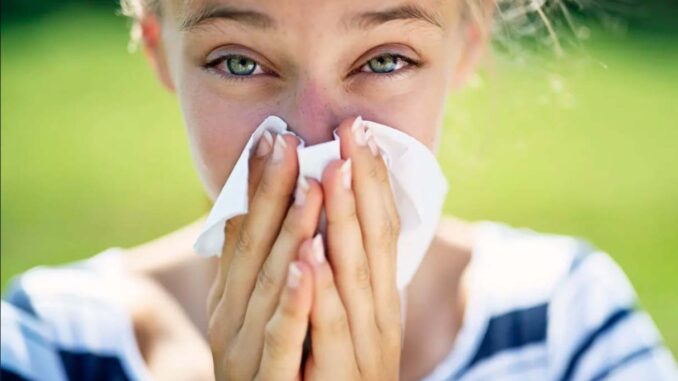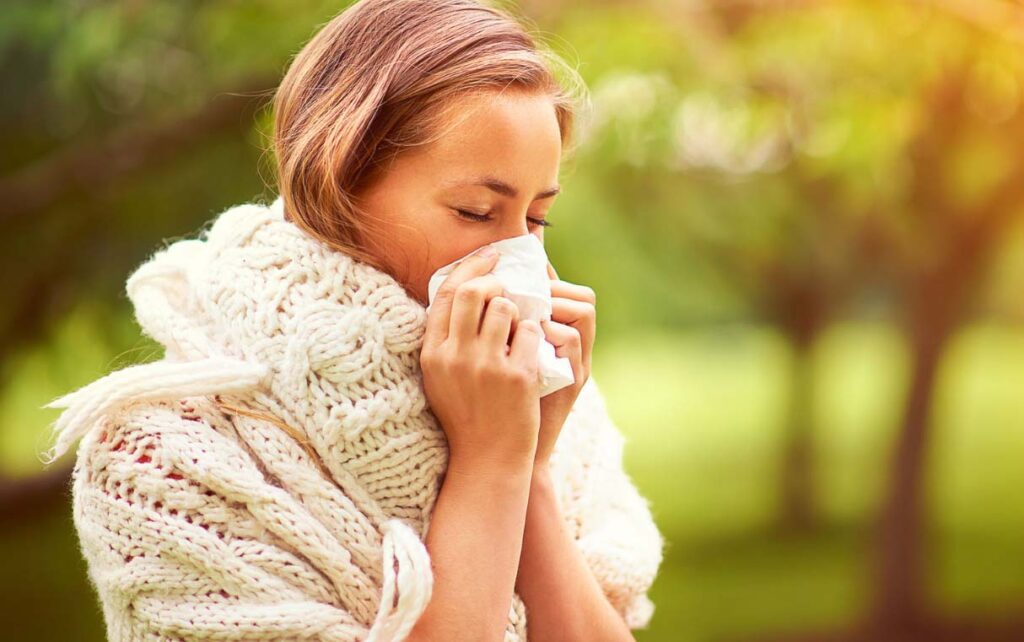
Allergies can significantly disrupt our day-to-day lives and greatly impact our overall quality of life.
My allergies were triggered during my pregnancy. They called it pregnancy rhinitis, assuring me that I’ll be fine once the delivery was over. For 8 years I continued to battle symptoms like sneezing, itchy eyes, and congestion.
The good news is – by understanding the causes of my allergies, I was able to take proactive steps to manage my symptoms and improve my quality of life.
By the end of this article, you’ll also have a better understanding of what’s causing your allergies and what you can do to feel better.
So let’s get started with a deep dive into the various triggers and risk factors that lead to the development of allergies.
What Causes Allergies?
Allergy can be caused can be anything from airborne allergens, foods, insect stings, and medications to latex, metal, cosmetics, or even pets (1).
Allergies can be broadly classified into 5 categories based on their causes:
- Food allergies
- Environmental allergies
- Drug Allergies
- Allergies triggered by hormones
- Allergies trigger by organisms
Let’s explore these in detail one by one.
1. Causes of Food Allergies

Food allergies are common but less common than food intolerances. Food allergy occurs when your immune system reacts abnormally to certain foods you eat. They are often a result of the immune system wrongly recognizing some of the proteins in foods as being harmful (2).
Most food allergies have symptoms like hives, wheezing, and stomach pain. Studies show that 8 different types of food cause about 90 percent of all food allergy reactions. They are:
- Cow’s milk
- Eggs
- Peanuts
- Soy
- Wheat
- Fish
- Tree nuts such as brazil nuts, almonds, cashews, macadamia nuts, pistachios, pine nuts, and walnuts
- Shellfish (crustaceans) such as shrimp, prawns, crayfish, lobster, squids, and scallops
But food allergies do not limit themselves here.
There is a big list that can trigger allergic reactions. You may have many questions regarding the causes of allergic reactions. Can coffee cause allergies? Can wine cause allergies?
Yes, they can.
- Coffee allergy: According to a 2012 study published in the International Archives of Allergy and Immunology, green coffee bean dust caused allergic reactions in some who worked in the coffee processing industry (3).
- Wine allergy: Wine contains grapes, ethanol, and yeast, any of which can act as an allergen. Ingredients used for fining the wine can also be the cause (4).
And the list goes on. Some other foods that tend to cause allergic reactions are black pepper, sesame seeds, banana, avocado, mustard seeds, aniseed, chamomile, seafood, sunflower, lemon, GMO, MSG, mint, pea protein, and nightshades.
2. Causes of Environmental Allergies

Environmental changes such as global warming are thought to be the main factor in the increasing number of allergic diseases (5).
1. Seasonal Allergies
As the seasons change, from winter to spring and summer, each brings its share of allergens.
- Spring allergies: Spring allergy is mostly triggered by pollen. For some, their immune system mistakenly sees the pollen as a danger and releases antibodies that cause reactions. Triggers include pollen from trees such as alder, ash, aspen, beech, box elder, cedar, hickory, cottonwood, juniper, oak, olive, and palm. The grasses and weeds that cause spring allergies are Bermuda, Fescue, Johnson, June, redtop, sweet vernal, and timothy.
- Summer allergies: These allergies are usually triggered by pollen from grasses and weeds. The real culprits are ryegrass and timothy grass. In fact, the Asthma and Allergy Foundation of America states that grasses are the most common triggers of hay fever (6).
- Fall allergies: Ragweed, mold, and dust mites are the main culprits triggering fall allergies. Other ones are nettles, mugworts, sorrels, fat hens, and plantains.
- Winter allergies: Winter allergies are mostly related to mold, pet dander, cockroaches, and dust mites. As you spend time indoors, the allergens that lie dormant can trigger allergic reactions.
- Rain allergies: Can rain cause allergies? Oh, yes! Rain brings with it its share of allergic reactions. When the grass and weed pollen is high, raindrops that hit the ground break the clump of pollen into smaller particles. This then quickly disperses in the air and causes allergic asthma symptoms (7).
2. Allergic Environmental Substances
- Cotton: Textile allergy is extremely rare. Cotton clothing may cause skin irritation but cotton allergy is related to exposure to cotton dust in the air which could lead to airway obstruction. Molds such as Alternaria and Aspergillus that are occasionally found in cotton crops can be the cause. Other natural contaminants of cotton are bacteria and endotoxins can trigger allergic reactions (8).
- Tobacco Smoke: Can smoke cause allergies? Many people feel that they are allergic to smoke from tobacco especially cigarettes, cigars, or pipes. The common symptoms that they experience are mainly breathing trouble, wheezing, watery eyes, headaches, and runny nose.
However, most doctors believe these allergic-like symptoms aren’t actually smoke allergies. The chemicals and toxic ingredients in tobacco products trigger a reaction in people who are sensitive to those specific substances (9).
However, there has been an incidence of contact dermatitis on touching tobacco products. Some have also reported allergic reactions in the mouth and lips while chewing tobacco.
3. Respiratory Allergies
Respiratory allergies, also known as allergic rhinitis (AR) are caused by the proteins in the air that when inhaled trigger inflammation of the airways.
Specific allergens such as smoke and fumes can aggravate these reactions. It induces an IgE-mediated response and shares many symptoms with allergic asthma (10).
Respiratory allergies can be caused by various components such as pollen, dust mites, pets, mold, etc. Sometimes allergy symptoms are seasonal.
A warmer climate leads to longer pollen seasons as an effect of climate change. Therefore an increased risk of respiratory allergic reactions is taking place.
4. Allergies Caused by Chemical Agents
Allergies from chemical agents are quite common. This includes artificial flavoring, preservatives, and antibacterials added to food products to increase their shelf life. Chemical substances used to thicken or lubricate a product can also very well be the cause.
Chemicals in hair dyes and different hair products can also be potential allergens. Other than that, formaldehyde resin, an ingredient in nail care products, and chemicals in lip balms, sunscreen, and moisturizers can also lead to allergies.
- Sulfite allergy: Some food, drinks, and medications contain sulfite as a preservative that can cause allergic reactions. Some people also react to medications that contain sulfonamide such as certain antibiotics. This is different from sulfite allergy though (11).
- Sulfur dioxide: Sulphide dioxide is a natural component that is produced while making beer and wine. It is also often used in wine. People who are asthmatic or are prone to allergic rhinitis may react when inhaling sulfur dioxide. Some people have experienced asthmatic attacks after drinking acidic drinks that contain sulfites.
- Latex allergies: Latex allergies often occur while using latex gloves and condoms.
- Perfume or Fragrance Allergy: Perfume allergy or fragrance allergy occurs when you have an allergic reaction after being exposed to them. It can result from getting sprayed, touching the liquid, or inhaling it. Several surveys reported that about 30 percent of the population of the United States complains of irritation from perfume (12).
More than 2500 fragrances are used in cosmetics that can cause fragrance allergies and are often unlisted. Fragrances in soaps, colognes, deodorants, moisturizers, cosmetics, and detergents can trigger an allergic reaction.
5. Allergies Caused by Metal
Metal allergies can be caused by nickel, zinc, chromium, titanium, sterling silver, stainless steel, cobalt, silicon, and gold.
In metal allergies, the skin cells pick up small molecules of metal that travel to the lymph nodes. Those substances are considered foreign invaders and trigger an immune response (13).
5. Triggers of Plant and Pollen Allergies
Plant allergies are caused by pollen and resin. Pollens from weeds, trees, and grass and resin from plants like poison ivy and poison oak are very common plant allergens (14).
- Pollen Allergy: Pollen allergy, also known as hay fever is often referred to by experts as seasonal allergic rhinitis. During spring, summer, and fall, plants release pollen grains that trigger allergic reactions. Some people have pollen allergies all year round whilst others have them only during specific times of the year.
People who are sensitive to birch pollen suffer during spring while those with ragweed allergies are affected during late spring and early fall.
3. Causes of Drug Allergies

A drug allergy is caused because of an abnormal reaction of your immune system to a medication. Drug allergy is a type of unpredictable reaction that refers to immunologically mediated drug hypersensitivity reactions (15).
Drug allergies are normally IgE or non-IgE mediated. Adverse drug reactions (ADRs) account for 3-6% of all hospital admissions and occur in approximately 10-15% of hospitalized patients.
- Sulfa allergy: Sulfa allergy is a drug allergy often reported and is associated with sulfa drugs. These drugs are mainly used to treat a range of health problems. Such as rheumatoid arthritis and eye infections.
Sulfa drugs, also known as sulfonamides, are used to treat many infectious diseases and are found in antibiotics and other drugs (16). Sulfamide allergy can be the cause of antibiotic allergies.
Some of the other drug-related allergies include:
- Penicillin allergy
- Aspirin allergy
- Clindamycin allergy
- Iodine allergy
- Steroid allergy
- Other common drugs such as NSAIDs, amoxicillin, cephalosporins, local anesthetics, general anesthetics, and sulfa drugs can also be the cause of allergic reactions.
Allergies Caused by Hormones and Neurotransmitters

Hormonal allergy is an allergic reaction caused by one’s own hormones. This can interfere with the normal functioning of the hormones and can occur premenstrually in women along with the variation in the menstrual cycle (17).
- Histamine intolerance: Mast cells produce and store histamine, the chemical responsible for inflammatory reactions of allergies. These cells also have estrogen and progesterone receptors. Therefore when estrogen binds to its receptors on these cells, it triggers histamine production and release. So the more is estrogen the more histamine is released that leading to a vicious histamine-estrogen cycle.
Estrogen also affects histamine metabolism by reducing DAO enzyme activity leading to more histamine production but less histamine excretion. This causes histamine intolerance and reaction.
Histamine-intolerant women experience headaches and other symptoms at ovulation or right before their periods. It can also cause more menstrual cramping.
Adrenal glands produce cortisol which plays a crucial role in controlling the body’s histamine levels. Therefore when this cortisol level is low (during cortisol deficiency), it can lead to allergic reactions. However, do keep in mind that stress doesn’t actually cause allergies but it can make allergic reactions worse by increasing histamine production in your bloodstream.
Allergies Caused by Organisms

Microorganisms such as fungi, yeast, virus, mold, and bacteria can lead to allergies. Bacteria, fungi, or viruses can also cause infectious rashes. Common viral rashes include mononucleosis, chickenpox, and shingles.
Other allergies caused by organisms are:
- Mold allergy: Mold allergy is triggered when you breathe in mold spores. Mold and mildew are fungi. Their seeds are called spores which travel through the air. Some spores in foggy weather when the humidity is high. Others spread in dry, windy weather. Inhaling these spores can cause allergic reactions (18), (19).
- Dust mite allergy: This is an allergic reaction that is triggered by tiny bugs that live in house dust. The symptoms of dust mite allergy are very much like hay fever. They are sneezing and have runny noses. In some people, dust mite allergy can lead to wheezing and breathing difficulties including asthma (20).
- Yeast allergy: Even though rare, IgE-mediated yeast allergy does exist. It can affect your whole body causing skin reactions, abdominal bloating, breathing difficulties, dizziness, and pain in the joint. Sources of yeast allergy may be bread and baked goods, yeast-containing alcoholic beverages, aged meats and olives, mushrooms, and fermented products. Yeast allergy can be the cause of wine allergy and beer allergies (21).
- Insect sting allergy: This can be caused by the stings of mainly five insects. They are honey bees, hornets, wasps, yellow jackets, and fire ants. Usually, insect stings cause non-allergic reactions that are concentrated in the bite area and result in local pain, itching, swelling, and redness. It lasts for 48 hours up to one week. Insect sting allergic responses occur in people who have developed antibodies against insect venom from prior exposure. Around 0.3-3% of stings trigger this systemic allergic reaction.
- Mosquito allergy: Mosquito allergy results from an allergy to mosquito bites. It is also referred to as Skeeter syndrome. People with this syndrome are extremely sensitive to these bites and can develop allergic reactions such as fever (22).
- Pet allergy: An abnormal immune reaction to proteins in an animal’s skin cells, saliva, or urine is termed a pet allergy. It is relatively common and often leads to sneezing, runny nose, wheezing, and/or difficulty breathing. Pet dander is tiny flecks of skin that are shed by pets such as cats, dogs, rodents, birds, and some other fur animals. Also known as pet dander allergy, these particles can cause allergic reactions in some (23). Allergies from fish and reptiles are rare but present.
Conclusion
To avoid allergens and manage our allergy symptoms, the first thing we need to do is to identify the cause of our allergies. Your genetics, diet, environmental factors, and lifestyle choices all play roles in the development of allergies.
A proper diagnosis and management of allergy symptoms can greatly improve your quality of life.
Read the next in our allergy series to learn about the signs and symptoms of allergies.
Read Next: Allergies: Signs and Symptoms of Allergies
